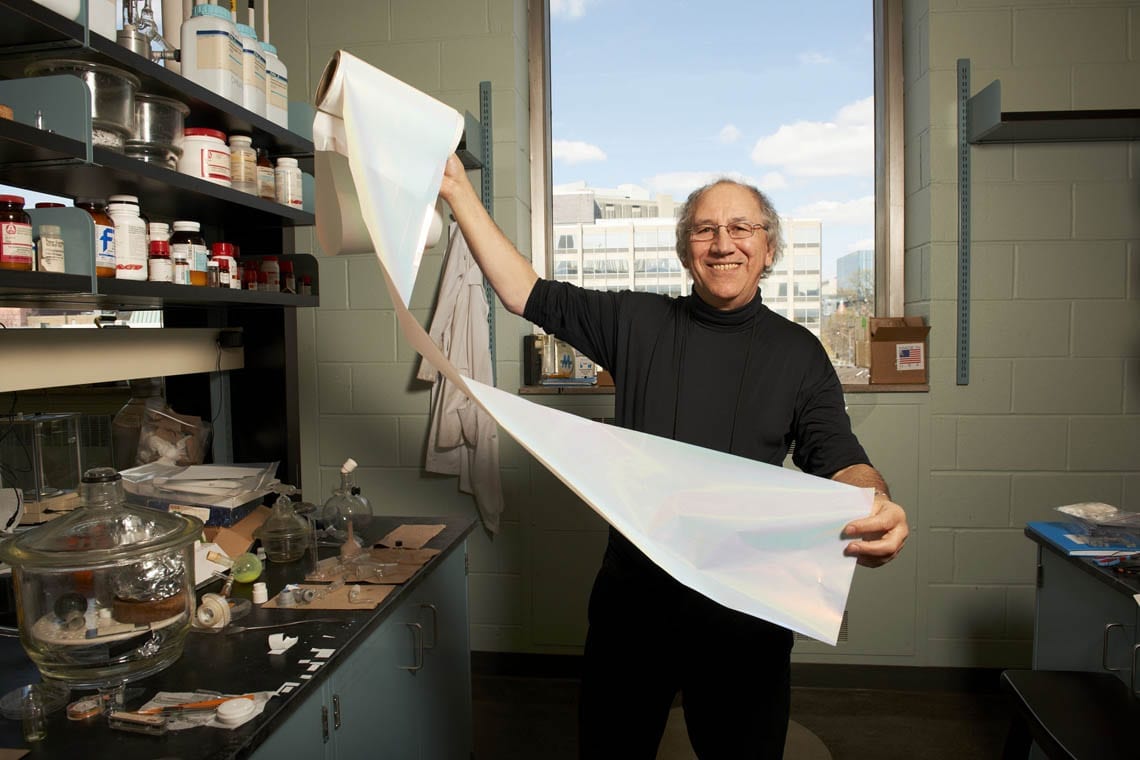
Every year, humans advance climate change and global warming – and quite likely our own eventual extinction – by injecting about 30 billion tonnes of carbon dioxide (CO?) into the atmosphere.
A team of U of T scientists believes they’ve found a way to convert all these emissions into energy-rich fuel in a carbon-neutral cycle that uses a very abundant natural resource: silicon. Silicon, readily available in sand, is the seventh most-abundant element in the universe and the second most-abundant element in the earth’s crust.
The idea of converting CO? emissions to energy isn’t new: there’s been a global race to discover a material that can efficiently convert sunlight, carbon dioxide and water or hydrogen to fuel for decades. However, the chemical stability of CO? has made it difficult to find a practical solution.
“A chemistry solution to climate change requires a material that is a highly active and selective catalyst to enable the conversion of CO? to fuel. It also needs to be made of elements that are low cost, non-toxic and readily available,” said Faculty of Arts & Science chemistry professor Geoffrey Ozin, the Canada Research Chair in Materials Chemistry and lead of U of T’s Solar Fuels Research Cluster.
In an article in Nature Communications published August 23, Ozin and colleagues report silicon nanocrystals that meet all the criteria. The hydride-terminated silicon nanocrystals – nanostructured hydrides for short – have an average diameter of 3.5 nanometres and feature a surface area and optical absorption strength sufficient to efficiently harvest the near-infrared, visible and ultraviolet wavelengths of light from the sun together with a powerful chemical-reducing agent on the surface that efficiently and selectively converts gaseous carbon dioxide to gaseous carbon monoxide.
The potential result: energy without harmful emissions.
“Making use of the reducing power of nanostructured hydrides is a conceptually distinct and commercially interesting strategy for making fuels directly from sunlight,” said Ozin.
The U of T Solar Fuels Research Cluster is working to find ways and means to increase the activity, enhance the scale, and boost the rate of production. Their goal is a laboratory demonstration unit and, if successful, a pilot solar refinery.
Learn more: U of T scientists solve puzzle of converting CO? emissions to fuel
The Latest on: Converting CO2 emissions to fuel
[google_news title=”” keyword=”converting CO2 emissions to fuel” num_posts=”10″ blurb_length=”0″ show_thumb=”left”]
via Google News
The Latest on: Converting CO2 emissions to fuel
- Fueling the future: Researchers evaluate emissions in the aviation industryon April 29, 2024 at 1:59 pm
A research group led Prof. Fei Wei and Chenxi Zhang in Tsinghua University has published a perspective paper that evaluates the progression from deep-rooted fossil-fuel-dependent technologies to ...
- Inspired by natureon April 28, 2024 at 5:00 pm
Converting carbon dioxide into methanol, a potentially renewable alternative fuel, offers an opportunity to simultaneously form an alternative fuel and cut down on carbon dioxide emissions. Inspired ...
- Reducing carbon emissions: Egypt’s project to replace and convert cars to run on natural gason April 24, 2024 at 5:00 pm
The fuel conversion project aims to reduce harmful ... lower emissions of carbon monoxide and 25 percent lower carbon dioxide emissions. The report also cited the UN Economic Commission for ...
- CSIR-IICT, BHEL developing tech to make clean fuel with CO2on April 20, 2024 at 6:17 am
CSIR-IICT (Indian Institute of Chemical Technology) and BHEL corporate R&D have joined hands to develop a technology for capturing and converting carbon dioxide (CO 2) into Dimethyl Ether (DME) ...
- CSIR-IICT and BHEL sign MoU for technology on CO2 to DMEon April 20, 2024 at 5:22 am
Utilization of captured CO2 to make DME is a sustainable process for capturing and converting CO2 to Dimethyl Ether a clean fuel to be used as a blend with LPG.
- CO2 worsens wildfires by helping plants growon April 16, 2024 at 1:38 pm
By fueling the growth of plants that become kindling, carbon dioxide is driving an increase in the severity and frequency of wildfires, according to a UC Riverside study.
- Inspired by natureon April 14, 2024 at 5:00 pm
Converting carbon dioxide into methanol, a potentially renewable alternative fuel, offers an opportunity to simultaneously form an alternative fuel and cut down on carbon dioxide emissions. Inspired ...
- Current Climate: Most CO2 Emissions Come From Just 57 Producerson April 8, 2024 at 4:00 am
The vast majority of carbon dioxide emissions comes from a very small group ... It delivered 40 hydrogen fuel cell trucks to customers in the fourth quarter, more than analysts expected.
- A high-efficiency photocatalyst for converting carbon dioxide into environmentally friendly energy using sunlighton March 28, 2024 at 5:00 pm
In this regard, research on photocatalysts, capable of reducing carbon dioxide emissions while simultaneously converting it into useful fuel, has been actively pursued. Photocatalyst research has ...
- Scientists find green way to turn CO2 into fuel with sunlighton March 27, 2024 at 4:25 am
Apart from using it at fossil-fuel-burning power plants, a major energy supply for Korea, the photocatalyst could also be used to process atmospheric CO2 gathered into tanks, he said, adding that ...
via Bing News










